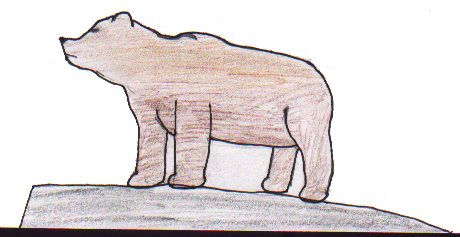 This collection of student work is from Frank Keim's classes. He wants to share these works for others to use as an example of culturally-based curriculum and documentation. These documents have been OCR-scanned and are available for educational use only.
This collection of student work is from Frank Keim's classes. He wants to share these works for others to use as an example of culturally-based curriculum and documentation. These documents have been OCR-scanned and are available for educational use only.Special | A | B | C | D | E | F | G | H | I | J | K | L | M | N | O
P | Q | R | S | T | U | V | W | X | Y | Z | ALL
Brownies by Matthew Shorty:HABITAT The Brown bear has the widest range of all bears in the world .It ranges much of the northern hemisphere, both east and west. Although Brown bears are found in a variety of areas, they prefer river valleys, mountain forests, and open meadows.
BROWN BEAR'S BODY The Brownie's body is rather chunky and has a lump on its back made of fat and muscle. The brown bear has a wide heavy head with a "dish faced" appearance. It also has very powerful jaws, and paws with very long claws.
HIBERNATION In all parts of the Brown bear's range, except in Turkey and Iran, the bear is in a den during the winter season. At the start of the denning season, they might have 6 to 10 inches of fat under their fur. The most common kind of dens are rock caves, or a hole dug under a large tree or into a snow drift. Depending on the weather, bears will den from the middle of September to November.
REPRODUCTION OF A BROWN BEAR Some Brown bears may live as much as thirty years old. One female was reported to have cubs when she was twenty- five years old in a zoo. Females don't usually breed until they are at least five years old. The breeding season is in June or July. The cubs are born in January or February. The usual size of a litter is two, but four is not uncommon. When cubs are born they are less than one pound, but when nursing they gain as much as thirty-three percent of fat. When the cubs are grown up they may weigh a thousand times more than their weight at birth. By MATTHEW SHORTY
| |
|




